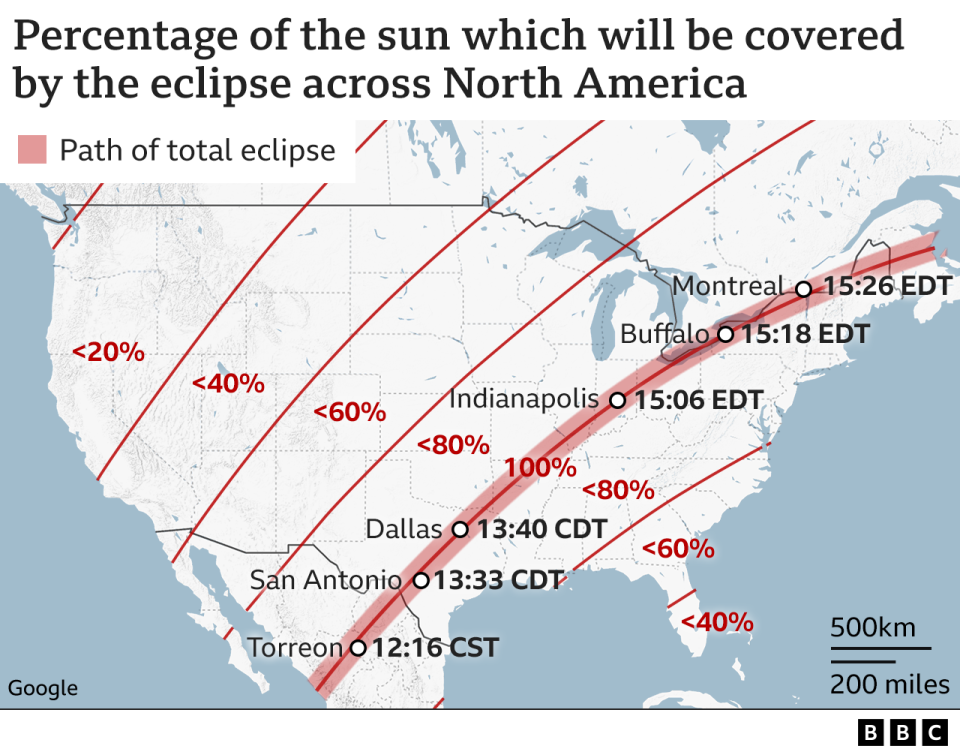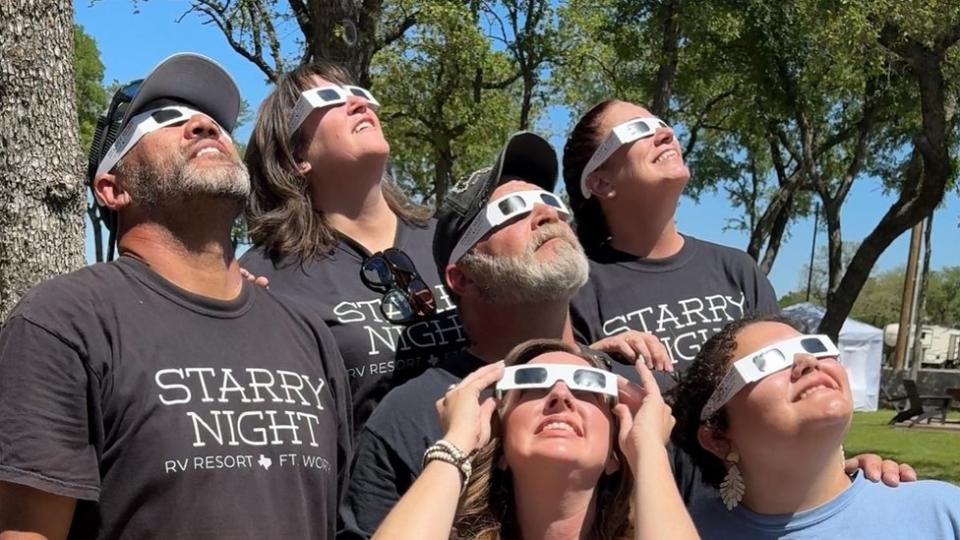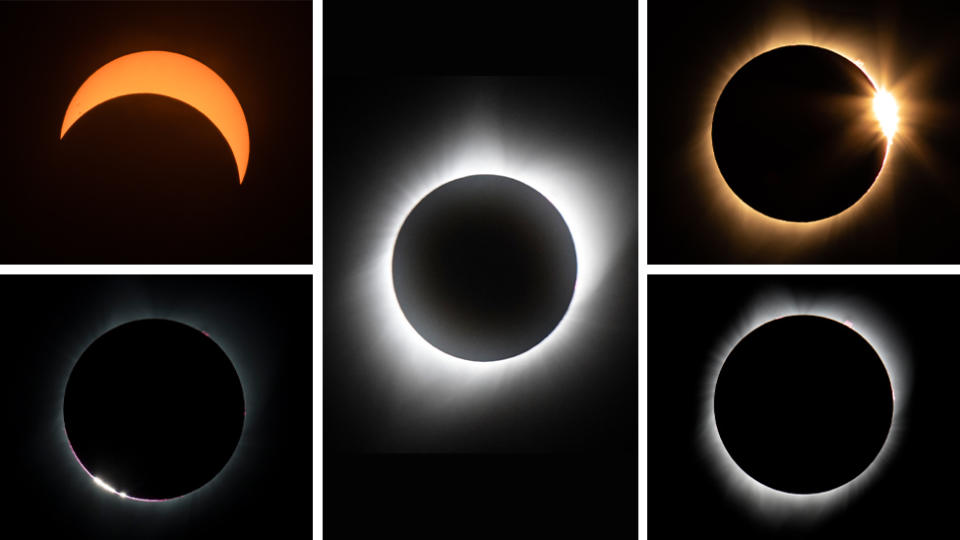Solar Eclipse: Anticipation grows as millions hope for clear skies
Eclipse watchers are keeping a close eye on the weather ahead of a solar eclipse that will plunge a wide strip of North America into daytime darkness on Monday.
Forecasters are predicting cloudy conditions in northern Mexico, Texas and parts of the Great Lakes region.
Better weather is expected in western Mexico and parts of the US Midwest.
And some of the best viewing is likely to be under clear spring skies in New England and Canada.
Starting in the Pacific Ocean, the eclipse will become visible on the coast of Mexico near the city of Mazatlan at about 11:07 local time (19:07 BST).
The shadow of the Moon will run across the Earth at a speed of 1,500 mph (2,400 km/h) - tracing a north-easterly arc through the states of Durango and Coahuila before casting parts of Texas, Arkansas and neighbouring states into darkness.
As the path crosses over the US Midwest, a phenomenon known as totality - when the Sun is completely obscured by the Moon - will cross over the cities of Indianapolis, Cleveland and Buffalo.
At around 15:18 Eastern (19:18 GMT) the eclipse will reach Niagara Falls, where a record crowd of up to a million people is expected to turn out to watch mist from the famous cataract turn a pinkish hue - provided the weather co-operates.
The shadow will continue to travel north east through the New England states and into Canada's Maritime provinces before tracking into the Atlantic Ocean and ending at 20:55 BST.
The eclipse is the first this century to cross over all three North American countries.
Here is a breakdown of when totality will occur in US and Canadian cities, all in local time:
San Antonio, Texas: 13:33 Central (19:33 BST)
Dallas, Texas: 13:40 Central
Carbondale, Illinois: 13:59 Central
Cleveland, Ohio: 15:13 Eastern
Buffalo, New York: 15:18 Eastern
Burlington, Vermont: 15:26 Eastern
Montreal, Quebec: 15:27 Eastern
Fredricton, New Brunswick: 16:33 Atlantic
Gander, Newfoundland and Labrador: 17:12 Newfoundland time
Special events, festivals and even mass weddings will take place in towns and cities across the path.
Nasa and its partner organisations are hosting more than 100 events, including gatherings where the eclipse will first be visible from land in Mazatlan, at the Cotton Bowl stadium in Dallas and at Indianapolis Motor Speedway in Indiana.
Crowds will fill a football stadium in Carbondale, Illinois, where the path of Monday's eclipse will intersect the path of the last solar eclipse to travel across the United States, in 2017.
The main variable for many viewers will be the weather down here on Earth.
In its latest eclipse forecast Sunday, the US National Weather Service warned of potential severe conditions including heavy rain, tornados and hail which may affect travel in Texas and nearby states. The view in San Antonio is expected to be almost entirely obscured by clouds.
However, cloudy conditions will not necessarily spoil the experience. No matter the weather, the sky will still dim considerably as the Moon's shadow travels across the Earth.

The Sun will be partially obscured even thousands of miles away from totality, but the most dramatic events will be experienced by those in the direct path. Some locations will experience totality for nearly four and a half minutes.
The Moon will completely cover the Sun, with only the corona - the star's bright outer atmosphere - visible. The temperature will fall and wind patterns and cloud formations could shift. Some animals will be tricked into thinking day has turned to night, and stars and planets might be visible in the sky.
Scientists will take advantage of the eclipse to perform experiments, launch rockets into the sky, observe animal behaviour and study the corona.

Ahead of the eclipse, authorities were reporting increased traffic and demand for places to stay from astronomy enthusiasts, some of whom planned their journeys months or years in advance.
According to Nasa, 31.6 million people live along the path of totality, and millions more are expected to travel to catch a glimpse of the celestial event.
Nasa estimates that 215 million US adults - 88% of the population - either directly or electronically viewed the last North American solar eclipse in 2017.
At the Starry Night RV Resort in Fort Worth, Texas vehicles full of eclipse watchers were rolling in to set up camp ready for the big moment.
Owner Lindsey Kuhn told the BBC: "It's becoming quite a big deal, people have driven here from all over."
"I've been trying to explain to my daughter that it's going to get dark, she asked 'will we have to go to sleep?'
"We're going to be together, put on our glasses and take a selfie, it's once in a lifetime for us."

Except during the period of totality, special glasses are needed to view the partial stages of the eclipse. Experts advise that regular sunglasses won't work and looking at the sun, even through a camera or smartphone, can cause eye damage in seconds.
Some schools are closed or have allowed students to be absent on Monday, while others have planned special viewing events.
If the weather does affect Monday's event, North American eclipse watchers will have a while to wait. The next total solar eclipse widely visible from the US and Canada will occur in 2044.
What are the stages of eclipse?
By Science Editor Jonathan Amos

Partial eclipse: The Moon progressively covers the Sun's disc. Everything gets darker and darker.
Diamond ring: The last vestige of strong sunshine decreases to a brilliant point of light, as if a big diamond.
Baily's Beads: As the diamond dissipates, any remaining light sparkles through deep valleys on the Moon's edge.
Totality: Day turns to night, but be aware also of changes in temperature, in the wind, in the clouds and in birdsong.
Corona: Your chance to see the Sun's hidden secret - the delicate tendrils of light in our star's outer atmosphere, its corona.
And then it all happens in reverse. Totality is broken by the beads. The diamond reappears and expands the light back to its normal blinding intensity, and the corona is hidden once more.

More on the solar eclipse
PATH OF DARKNESS: Scroll the route of total eclipse
FANATICS: How much it costs to chase the eclipse

Are you planning on watching the eclipse? Where are you watching from? Share your experiences and pictures by emailing haveyoursay@bbc.co.uk.
Please include a contact number if you are willing to speak to a BBC journalist. You can also get in touch in the following ways:
WhatsApp: +44 7756 165803
Tweet: @BBC_HaveYourSay
Please read our terms & conditions and privacy policy
If you are reading this page and can't see the form you will need to visit the mobile version of the BBC website to submit your question or comment or you can email us at HaveYourSay@bbc.co.uk. Please include your name, age and location with any submission.

